33 Best Places to Visit in Varanasi, Uttar Pradesh
by Vagatrip
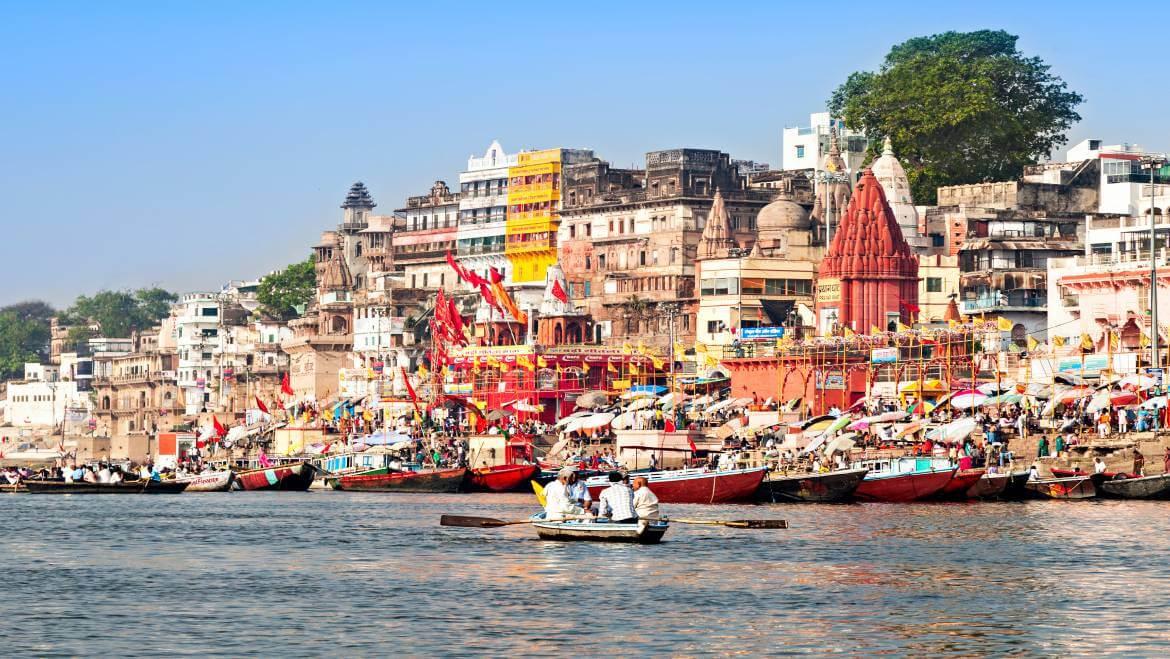
The heart of the city of lights or Kashi Varanasi has been beating for 3000 years and its lifeline is its scenic spiritual legacy. It is believed that Lord Shiva founded the holy city of Varanasi. It is the most popular Hindu pilgrimage destination in India. It is truly a representation of authentic India.
The aartis and the floating of earthen lamps over the water of River Ganga in the evening is also an important element of the identity of Varanasi. It is also an auspicious place for death. It is said that people who die here will be free from the cycle of birth and death. Apart from that the beautiful architectural wonders of the kings of Bengal and Maharajas of Rajasthan makes Varanasi a colorful palette of artistic wonders, faith and rich cultural heritage. Quick Information and Facts on Varanasi Tourism.
Let’s embark on a journey of the holy city of Varanasi and show you some of the best places to see.
Best Religious Places to Visit in Varanasi
Must Visit Temples in Varanasi, Uttar Pradesh
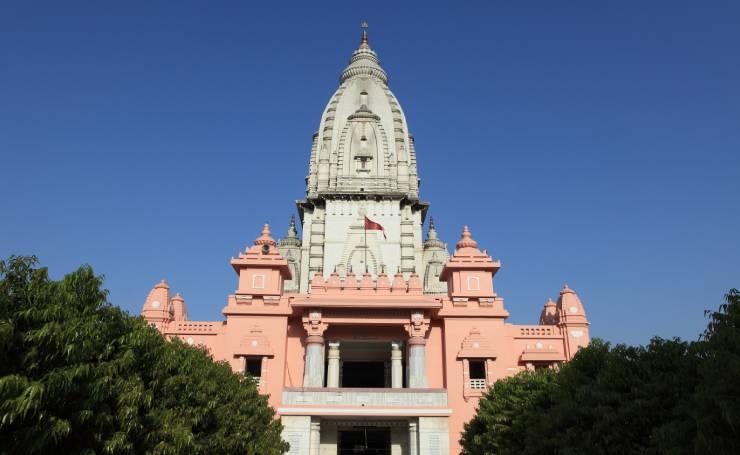
New Vishwanath Temple- Peace Land
Discover the exquisite New Vishwanath Temple, a sacred gem nestled within the serene premises of Banaras Hindu University (BHU) in Varanasi. This must-visit pilgrimage destination, also fondly known as the Birla Temple, was artfully crafted by the renowned Birla family. A true marvel, this temple complex proudly houses not just one but seven beautifully designed temples.
As you step into this divine abode, you'll be enchanted by the tranquil presence of Lord Shiva's temple, gracefully resting on the ground floor. Ascend to the first floor to encounter the resplendent Durga Temple and the divine Lakshmi Narayan Temple, both offering a peaceful haven for spiritual seekers.
The architectural splendor of the New Vishwanath Temple takes inspiration from the ancient Vishwanath Temple, capturing the essence of timeless beauty. Crafted from pristine white marbles, the temple's facade exudes an ethereal charm that radiates elegance.
As you wander through the temple's sacred halls, your eyes will be captivated by the verses of the Gita adorning the walls. This awe-inspiring sight adds a touch of profound wisdom to the temple's already enchanting ambiance, leaving an indelible impression on every visitor.
Prepare to embark on a journey of spiritual rejuvenation as you immerse yourself in the divine aura of the New Vishwanath Temple. An experience that will undoubtedly stay with you long after you bid farewell to this spiritual haven.
Kathwala Temple – Unique and surreal
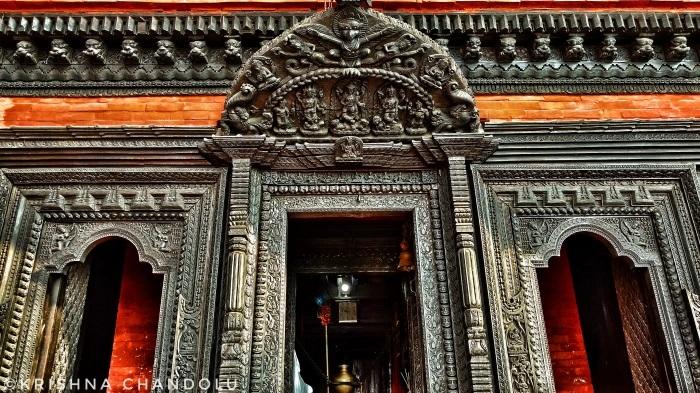
In the heart of Varanasi lies a place of divine allure, the Kathwala Temple, a cherished gem among religious sanctuaries. Often referred to as the Nepali Temple, its origins can be traced back to the illustrious King of Nepal, Rana Bahadur Shah, who bestowed this architectural marvel upon the city in the 19th century.
The temple's splendor is a captivating blend of Nepali finesse and artistry, adorned with the exquisite woodwork known as "Kath" in the Nepalese language, thus earning its revered title as the Kathwala Temple. Gazing upon its breathtaking design, one can't help but draw comparisons to the grandeur of the renowned Pashupatinath Temple in Kathmandu.
Step into the realm of Kathwala Temple, and marvel at its awe-inspiring Khajuraho style sculptures, a unique sight that sets it apart from the rest. Nestled gracefully on the banks of the sacred Lalita Ghat, it beckons pilgrims and visitors alike, drawing them in with its enigmatic charm.
As the sun sets over the horizon, the temple's allure seems to transcend time itself, casting a mesmerizing spell on all who witness its magnificence. So, if you find yourself in Varanasi, a visit to the Kathwala Temple is an absolute must—a journey that promises to enrich your soul and leave you with indelible memories of its divine grace.
Kashi Vishwanath/ Golden Temple – Dipped in spirituality
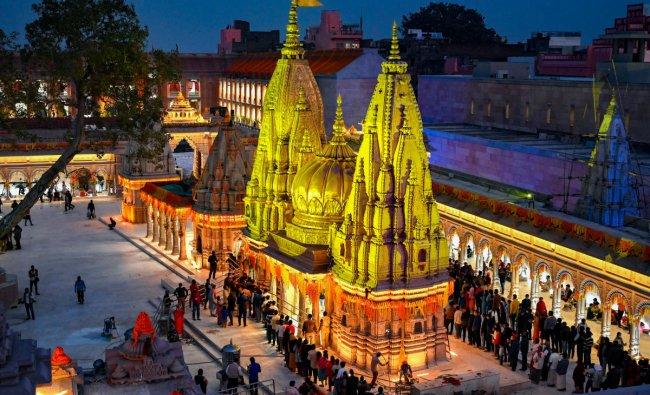
Explore the enchanting beauty of Varanasi, where the Kashi Vishwanath Temple stands tall as the most revered pilgrimage destination. Steeped in history, this sacred shrine boasts a legacy that spans an incredible 3500 years. Beholding the divine significance of being one of the 12 Jyotirlingas, it holds a special place among the holiest Shiva temples.
The celestial origin of this temple is a tale of wonder. It is said that the fiery radiance of Lord Shiva, manifested in the form of the Jyotirlinga, descended from the heavens to grace the earthly realm precisely at this hallowed location. Truly, a divine marvel!
At the heart of this grand sanctuary lies the Linga, serving as the presiding deity, surrounded by a captivating quadrangle embraced by other temples dedicated to various gods. Once adorned with a resplendent golden spire and domes, the temple was fondly known as the Golden Temple, a symbol of opulence and devotion.
Delving into history, we find that the temple's construction took place in 1780, skillfully crafted under the patronage of Maharani Ahilyabai Holkar of Indore. An architectural masterpiece, indeed!
Situated in the renowned Kashi Vishwanath Gali, the temple's surroundings are as vibrant as its spiritual aura. The bustling street, adorned with a variety of shops, adds to the charm of this sacred place.
Prepare yourself for an unforgettable journey to the Kashi Vishwanath Temple – a harmonious blend of ancient heritage and everlasting devotion. Experience the blissful atmosphere and immerse yourself in the divine energy that has attracted pilgrims from far and wide for centuries.
Highlights
Temple Timings for Sugam darshan – 6:00am to 6:00pm
Also visit Annapurna Temple, Dundiraj Vinayak and Gyanvapi which are located near Kashi Vishwanath temple.
Tulsi Manas Temple – Reviving the old Bhakti Poet
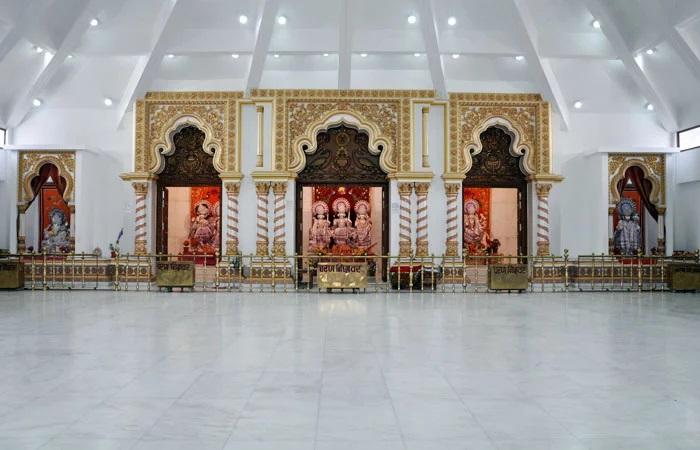
Indulge in a truly blissful spiritual experience during your holidays in Varanasi by visiting the enchanting Tulsi Manas Temple. This sacred place is a tribute to the revered Indian Bhakti poet, Goswami Tulsidas, and was meticulously constructed in 1964, using pristine white marble.
As you step inside, prepare to be mesmerized by the awe-inspiring architecture that will surely touch your heart. The temple's walls are adorned with intricately engraved scenes and verses from the renowned epic, Ramcharitmanas, transporting you to a divine world of devotion and love.
Legend has it that this divine temple stands on the very spot where Goswami Tulsidas composed the timeless Indian epic. Dedicated to the embodiment of virtue and righteousness, Lord Rama, the Tulsi Manas Temple exudes an aura of serenity and reverence.
To enhance your spiritual journey, the temple is conveniently located near the esteemed Durga Temple, making it an ideal place to explore and immerse yourself in the rich cultural heritage of Varanasi.
Allow the peaceful ambiance and sacred aura of Tulsi Manas Temple to uplift your soul and leave you with unforgettable memories of a truly divine experience during your spiritual holidays in Varanasi.
Temple Timings: 5:00am -12:00pm and 3:00pm to 9:00pm
Monkey Temple – Epitome of Peace
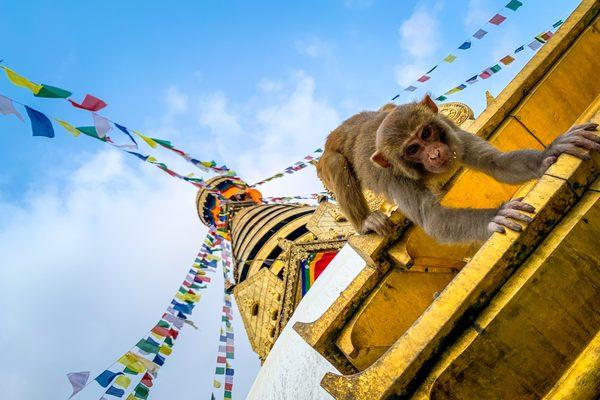
One of the city's most cherished religious destinations. Dedicated to goddess Durga, this enchanting temple has earned its popular nickname due to the delightful abundance of monkeys that call it home. Beyond its charming residents, the temple holds even more captivating wonders for its visitors.
Among its fascinating features is a sacred Kund, believed to be connected to the holy waters of the Ganga River, imparting it with therapeutic properties. Pilgrims from all corners of India journey to this sacred site to seek divine blessings and immerse themselves in the soothing melody of Bhajans and heartfelt prayers, yearning for spiritual grace.
Legend has it that the presiding deity of the temple manifested naturally, a divine marvel untouched by human hands. The temple itself stands as an architectural marvel, fashioned in the splendid Nagara style, and credited to the benevolence of a Bengali Maharani.
While the temple's captivating beauty and serene ambiance welcome visitors of all backgrounds, the inner sanctum remains a sacred space exclusively accessible to Hindu devotees. Nonetheless, the temple's courtyard invites all to revel in the divine aura and embrace the profound spiritual experience it offers.
As you step into the Monkey Temple's realm, prepare to be enchanted by the harmonious blend of nature, faith, and architectural splendor that leaves an indelible mark on every soul that graces this hallowed ground.
Bharat Mata Temple – I Love My India
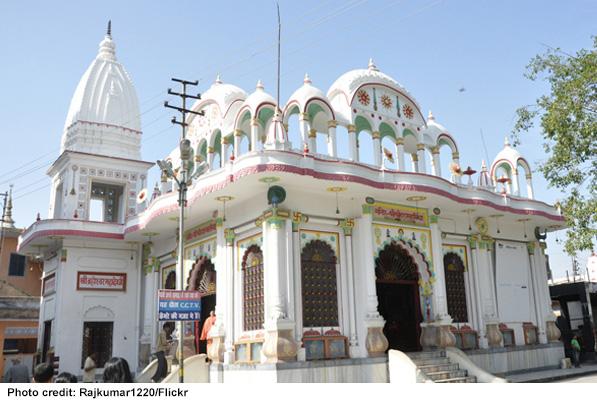
A truly remarkable and unique temple unlike any other. Instead of paying homage to a specific deity, this sacred place is devoted to Bharat Mata, the personification of India as a nurturing mother. Nestled within the serene Mahatma Gandhi Kashi Vidyapeeth Campus, this temple holds a rich history.
Back in 1936, the temple was inaugurated by none other than Mahatma Gandhi himself, becoming an inspiration for those actively involved in the fight for independence. Within its hallowed walls, a beautiful statue stands, symbolizing the diverse landscapes of India – from majestic mountains to expansive plains and the vast oceans that surround our nation.
But that's not all that captivates visitors. The temple's main attraction is an exquisite relief map of India, meticulously carved on pristine marble, showcasing the incredible topography and beauty of our land. The idol of Bharat Mata within the temple embodies the spirit of our entire nation, making it an absolute must-visit destination in Varanasi.
A testament to the vision and devotion of Babu Shiv Prasad Gupt, the architect behind this magnificent creation, this temple stands as a testament to the enduring spirit of India. So, if you find yourself journeying to Varanasi, make sure to grace its peaceful shore and experience the profound serenity of this remarkable temple dedicated to Bharat Mata.
Temple Timings – 9:30 am to 8:00pm
Alamgir Mosque – Timeless Mosque
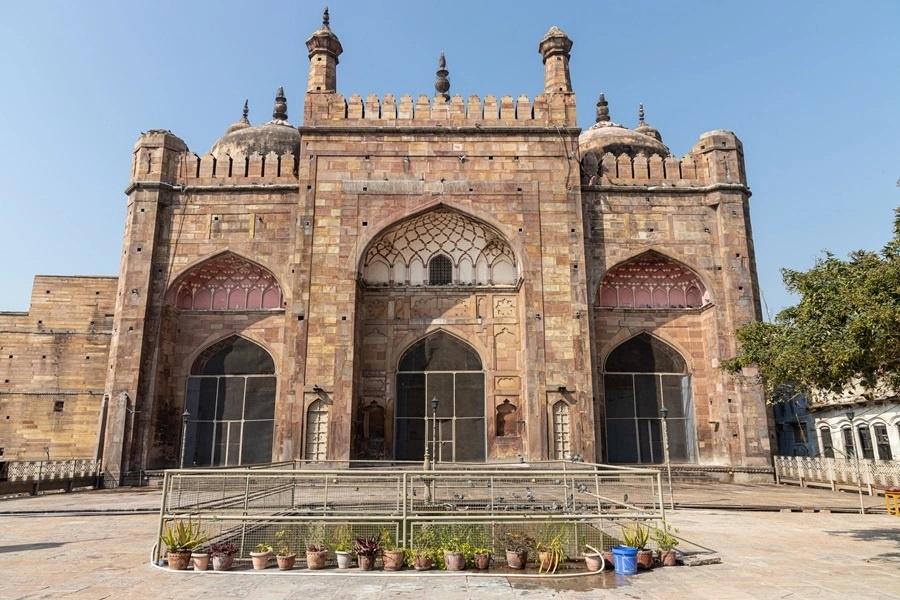
Alamgir Mosque, a majestic sanctuary nestled near the enchanting Panchganga Ghat, where tranquility and blessings converge. Proudly overlooking the flowing River Ganga, this sacred place bestows a picturesque panorama upon its visitors.
History tells us that Alamgir Mosque was commissioned by the illustrious Mughal Emperor Aurangzeb. Legend has it that the mosque stands on the very spot where the revered Kashivishwanath Temple once stood, as a symbol of architectural magnificence and spiritual devotion. Some also refer to it as Gyanvapi Mosque, paying homage to the nearby well with the same name.
Delightfully unique, Alamgir Mosque exhibits an amalgamation of North Indian and Hindu influences, artfully blended with Islamic architecture, rendering it a stunning masterpiece. This captivating fusion truly embodies the harmony and cultural diversity of the region.
Embracing the name "Dharhara Mosque," Alamgir Mosque stands as a testament to the rich history and spiritual heritage of India, welcoming all with open arms. Whether you seek solace, historical insight, or simply a moment of serenity amidst beauty, this divine haven promises an unforgettable experience.
Parshvanath Jain Temple – Sooth your eyes with Serenity
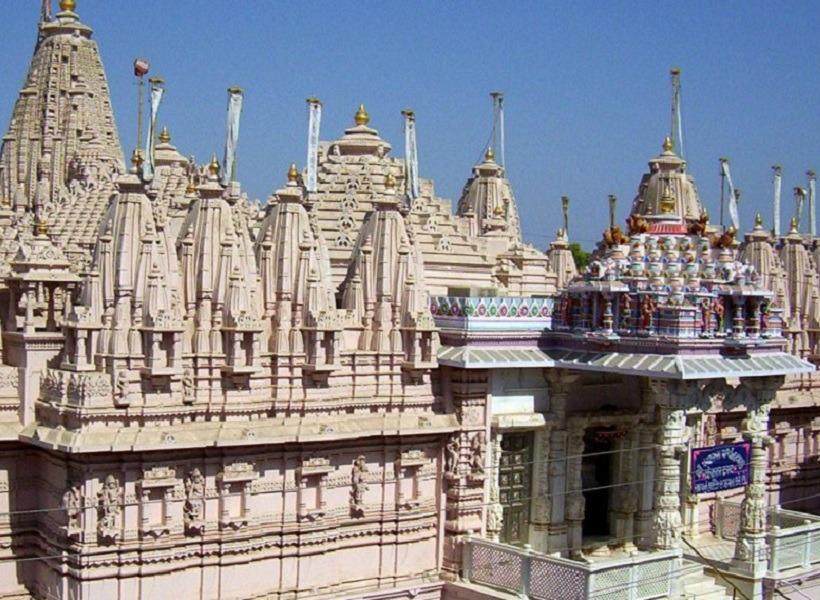
Nestled near the serene Panchganga Ghat, the Alamgir Mosque stands tall with an air of pride, bestowing blessings upon its devoted visitors. Positioned gracefully by the banks of the sacred River Ganga, it embraces a truly picturesque setting that captivates the soul.
Legend has it that this majestic mosque was commissioned by the illustrious Mughal Emperor Aurangzeb, who is said to have replaced the ancient Kashivishwanath Temple with this architectural marvel. Named after the renowned Gyanvapi well, which graces its vicinity, the Alamgir Mosque is also affectionately known as the Gyanvapi Mosque.
What makes this structure all the more intriguing is the delightful fusion of North Indian or Hindu architectural elements, harmoniously intermingling with the essence of Islamic design. A testament to the rich cultural heritage of India.
Undeniably, the Alamgir Mosque exudes a timeless charm that has earned it the affectionate moniker "Dharhara Mosque." Its grandeur and magnificence are a sight to behold, inviting all to marvel at its splendid beauty while basking in the divine aura that surrounds it.
Kalbhairav Temple – Seek Holy Blessings
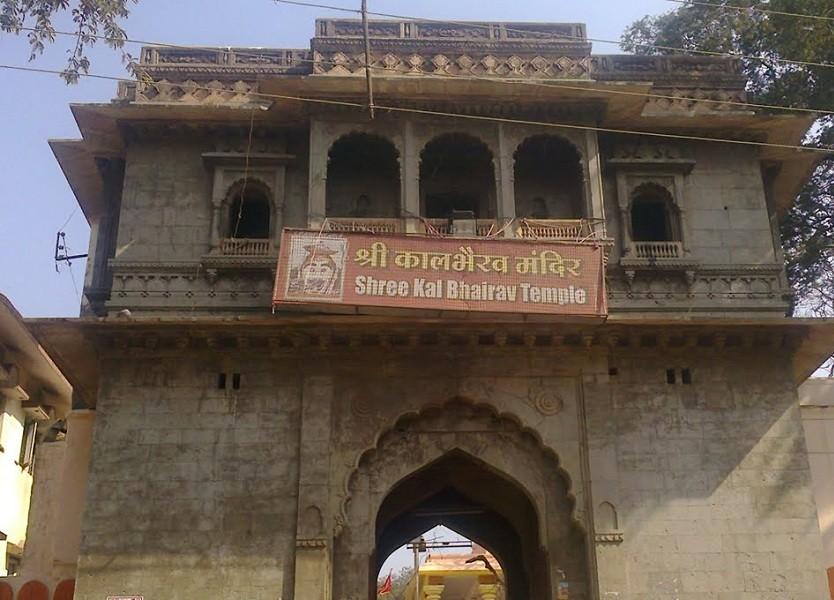
Mystical realm of Varanasi, where the Kalbhairav Temple stands tall, beckoning devotees from all walks of life. This sacred sanctuary is a haven of devotion, dedicated to the formidable Lord Bhairav, a profound incarnation of Lord Shiva himself.
In the heart of Varanasi, this revered temple holds a unique significance, as it is believed that Lord Kalabhairava presides over the decision of who stays in this divine city. Hence, it is no wonder that seekers of blessings and divine guidance make it their first stop upon arriving in Varanasi.
Even those who depart from this hallowed place cannot escape its magnetism. With hearts full of reverence, they pause at this sacred abode to seek the Lord's permission before embarking on their journey beyond these sacred grounds.
Devotees, adorned with humility, offer tokens of their devotion in the form of Sesame oil and delicate flowers to the divine deity. The air is filled with the fragrant essence of these offerings, a testament to the earnest prayers that ascend to the heavens.
Within the temple, a sense of mystery and holiness prevails, for the inner sanctum's back entrance is shrouded in secrecy and accessible only to the blessed hands of the temple priest. This sacred space holds the very essence of divinity, guarded by the powerful presence of Lord Kalbhairav.
The Lord's benevolence extends further, as He is known as the protector of the sacred Sati Pind. No soul dares to touch the sacred relic without first seeking the explicit permission of the divine guardian himself, Lord Kalbhairav.
In Varanasi's sacred embrace, the Kalbhairav Temple stands as a symbol of unwavering faith and divine guidance. Devotees from all corners of the world seek solace here, drawn to the aura of tranquility and the assurance that their prayers reach the heavens.
Let the Kalbhairav Temple be your spiritual compass, guiding you through the journey of life with grace and protection. In the shadow of Lord Bhairav, may your soul find solace and your spirit find eternal peace.
Temple Timings – 5:00 am to 1:30 pm and 4:30 pm to 9:30 pm
Must Popular Ghats of Varanasi
Dasaswamedh Ghat
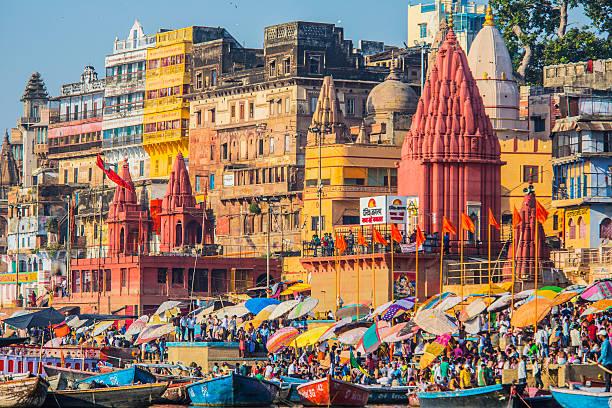
The ancient city of Varanasi, where time seems to stand still and traditions breathe life into its historic ghats. Among them, Dasaswamendha Ghat holds the distinction of being the oldest, emanating an aura of timeless charm. As the sun gently descends, the ghat comes alive with bustling activity, drawing visitors from far and wide.
Considered the crown jewel of Varanasi's attractions, Dasaswamendha Ghat captivates tourists with its mesmerizing ambiance. Located in close proximity to the revered Vishwanath temple, the ghat enjoys a prestigious position in the heart of the city. Its enchanting evening aarti is a spectacle that has etched itself into the memories of countless visitors.
Once you set foot on this sacred land, you'll be embraced by a diverse crowd, including wise sadhus, devoted sanyasis, humble beggars, and faithful devotees, all coming together in harmony. As the golden rays of the setting sun caress the waters, the air fills with spiritual fervor, leaving an indelible impression on your soul.
During the captivating evening aarti, the ghat transforms into a tapestry of lights. Devotees gently release earthen lamps, gracefully floating on the serene waters of the Ganges. The sight is nothing short of magical, evoking a sense of awe and tranquility that can hardly be matched elsewhere.
Dasaswamendha Ghat stands tall as a symbol of Varanasi's rich heritage and spiritual legacy. Its timeless allure is a testament to the unbroken traditions that have withstood the test of time. A visit to this hallowed ghat promises an experience of a lifetime, one that will leave you with memories to cherish for eternity.
Come, let your senses be enraptured by the captivating beauty of Dasaswamendha Ghat – a place where the past meets the present in a harmonious dance of spirituality and grace.
Highlights
1. The most sacred Ghat of Dasaswamedh is famous for its Ganga Aarti. The priest worships the holy river of Ganga which is the lifeline of Varanasi.
2. The duration of Aarti is 45 minutes and one must visit this place to experience the divine aura of Banaras. Your holidays in Varanasi would remain incomplete without experiencing the holiness of Smaller Diyas are floated by devotees in a leaf platter in the honor of holy river Ganga.
3. It is a place where the creator of the universe Lord Brahma sacrificed ten horses.
4. The ghat was constructed by Queen of Indore – Ahilyabai Holkar in 1774.
Assi Ghat
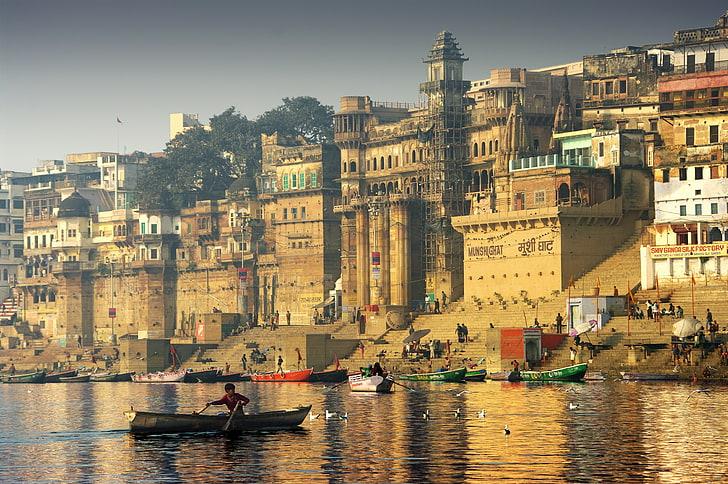
This sacred Ghat is situated on the confluence of the River Ganga and Assi. The devotees bathe here prior to paying homage to a huge Shiva Lingam placed under a tree in close proximity to this ghat. It is a must visit tourist attraction in Varanasi. The ghat is situated at the south of the city and therefore is less crowded. However, it doesn’t by any means indicate that the ghat holds any less importance than other ghats.
Highlights
It is a meeting point of River Ganga and Assi River.There is an idol of Lord Shiva which is kept beneath the Peepal tree and it is worshipped by devotees from all over the world.The evening Aarti of Assi Ghat is the center of attraction for devotees. Every evening, priests chant mantras and honor the holy river Ganga.The sight of the evening Aarti will blow your heart away. It looks ethereal.It is said that Goddess Durga killed the demon called Shumbha- Nishumbha and after killing them she threw her sword in the Assi River.
Manikarnika Ghat
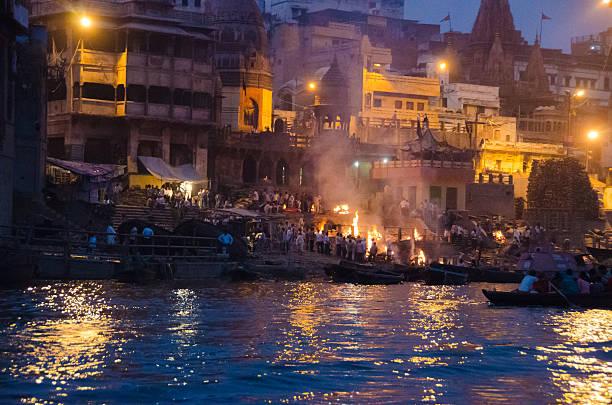
Manikarnika, an ancient Ghat in Varanasi, holds significant reverence as the primary cremation site. It stands proud as one of the oldest Ghats in the city and is famously referred to as the "Burning Ghat" due to its regular use for cremations. According to Hindu mythology, this sacred place is believed to be where a cherished ornament worn by Sati on her ear fell as Lord Shiva carried her to the Himalayas.
The prevailing belief among the locals is that those who find their final resting place here attain "Moksha," liberation from the cycle of life and death. Consequently, it's no wonder why Manikarnika Ghat is considered one of the most spiritually significant spots in Varanasi.
Aside from its spiritual significance, Manikarnika Ghat also captivates tourists with its historical allure and picturesque setting. Its unique blend of sacred rituals and ancient architecture makes it an exceptional place to visit while exploring the enchanting city of Varanasi.
Highlights
1. Located between Dasaswamedh Ghat and Scindia Ghat, Manikarnika Ghat is one of the most important places for cremation.
2. It is believed that the pond near Manikarnika Ghat was built by Lord Vishnu for Lord Shiva and Goddess Shakti to bathe. There is a footprint of Lord Vishnu near the pond.
3. It is said that Goddess Shakti dropped her earring in Manikarnika well. It is here Lord Shiva dug a hole to find the earring, the depression of which was filled with his sweat. This is the reason why Manikarnika well was constructed.
Man Mandir Ghat
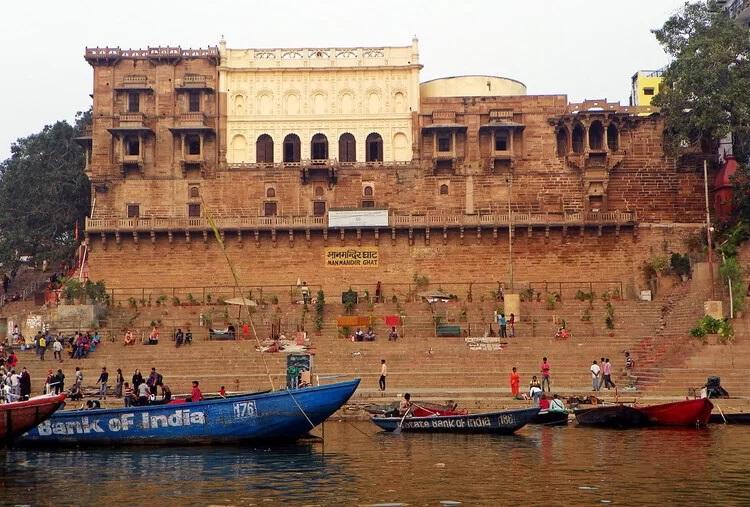
A serene and picturesque location nestled just north of the renowned Dasaswamedh Ghat in the ancient city of Varanasi. This charming Ghat carries a fascinating history dating back to the 1600s, credited to the visionary Maharaja Man Singh, who crafted this architectural gem.
As you stroll along the Ghat's enchanting path, your eyes will be drawn to a splendid stone balcony gracing its northern corner. The intricate craftsmanship of this balcony is a testament to the artistry and skill of the artisans who crafted it.
Moreover, Manmandir Ghat boasts the presence of several revered temples in its vicinity. The Sthuladanta Vinayaka Temple, the Rameshwara Temple, and the Someshwara Temple stand as a testament to the city's rich religious heritage, offering a sense of spiritual tranquility to all who visit.
Whether you seek solace, historical marvels, or a glimpse into the tapestry of Varanasi's culture, Manmandir Ghat welcomes you with open arms. Embrace the elegance and serenity of this place as you immerse yourself in the timeless charm it exudes.
Highlights
1. Manmandir Ghat is also known as Someshwara Ghat as the sacred lingam of Lord Someshwar was found here.
2. This Ghat is decked with numerous Hindu Deities which makes it the best place to visit in Varanasi for spiritual wisdom seekers.
3. From the stone Balcony the mesmerizing views of River Ganga will seduce your senses.
Shivala Ghat
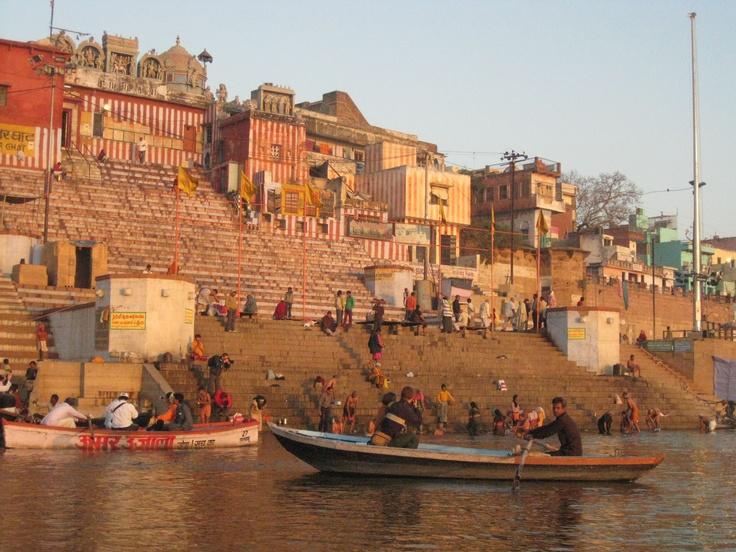
The enchanting allure of Shivala Ghat, a timeless gem nestled amidst the sacred city of Varanasi. This picturesque Ghat stands proudly as a testament to a bygone era, exuding an aura of history and spirituality.
At the heart of Shivala Ghat lies a marvel of architectural brilliance - the revered Shiva Temple. Adorned with exquisite craftsmanship, this temple was lovingly crafted by the skilled hands of a Nepalese monarch, King Sanjay Vikram Shah, during the 19th century. Its majestic presence continues to captivate visitors, leaving them in awe of its grandeur.
Steeped in tradition, Shivala Ghat holds a special place in the hearts of devoted pilgrims who flock here to immerse themselves in the sanctifying waters. The cleansing ritual, believed to purify both body and soul, attracts devotees from far and wide, drawn to the spiritual energy that emanates from this sacred spot.
With every step taken along the ancient stones of Shivala Ghat, one can't help but feel connected to the past and the spiritual essence that permeates the air. Embrace the tranquility and embrace the history as you delve into the mystique of this revered place, where time seems to stand still, and the divine beckons all who seek solace and enlightenment.
Highlights
1. Shivala Ghat in Varanasi is one of the offbeat Ghats to visit in Varanasi. It is less crowded and the center of the attraction of this Ghat is its Colony- Shivala Colony.
2. It got its name from the guardian deity of Kashi – Lord Shiva.
3. Shiva Temple, Brahmendra Math and numerous other Lord Mahadeva Temples, fortress of Oudh Nawab and 19th-century exquisite mansion of Nepali royal, King Sanjay Vikram Singh are the major tourist attractions to see in and around Shivala Ghat.
4. Shivratri is the best time to visit Shivala Ghat.
Harishchandra Ghat
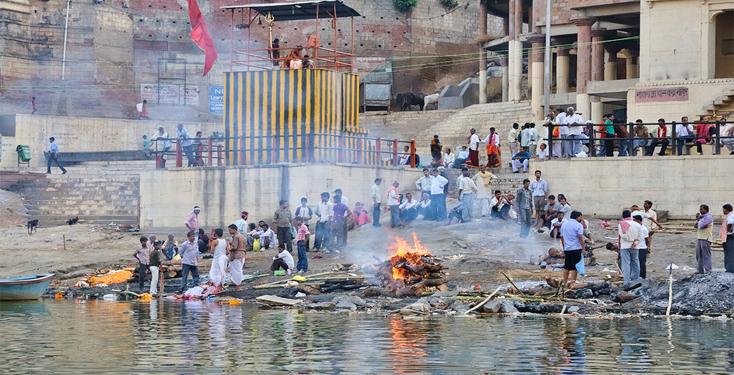
The serene and hallowed grounds of Harishchandra Ghat – a place steeped in ancient myth and profound spirituality. This ghat derives its name from the illustrious Raja Harishchandra, a revered figure in mythology, known for his unwavering righteousness and unyielding truthfulness. His humble demeanor was so pleasing to the gods that they bestowed upon him the restoration of his lost kingdom and even revived his departed son.
Nestled along the sacred banks of the Ganges in Varanasi, Harishchandra Ghat holds a special significance as one of the two ghats dedicated to cremation rituals. It is believed that those who find their final resting place here attain Moksha, the ultimate liberation of the soul.
As you immerse yourself in the tranquil ambiance of this place, you can't help but be touched by the profound legacy of Raja Harishchandra and the profound belief in attaining salvation through the rituals performed on this sacred site. May the sacred flame that burns eternal here, guide the souls to their divine destiny, and may the timeless teachings of truth and righteousness inspire all who visit this ethereal ghat.
Highlights
1. Harishchandra Ghat is one of the most prominent Ghats of Varanasi for cremation.
2. It is said that King Harishchandra worked in this Ghat for the establishment of truth and charity.
3. This Ghat houses an electric crematorium.
Tulsi Ghat
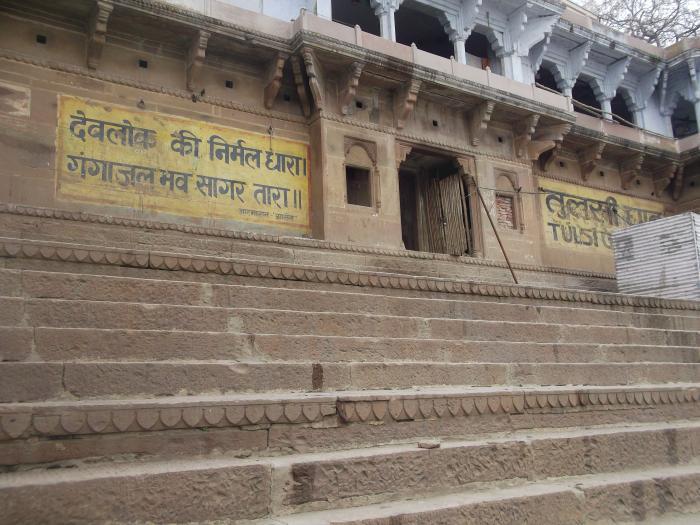
The enchanting Tulsi Ghat, a place of great significance named after the illustrious poet Tulsidas, the revered author of the Hindu epic Ramcharitramanas. Legend has it that this very ghat witnessed the creative brilliance of Tulsidas, where he immersed himself in writing a substantial part of the timeless Ramcharitramanas.
The essence of divinity fills the air as you stand by the riverside, for it is at this sacred ghat where a magnificent temple stands, devoted to none other than Lord Rama himself. The temple stands as a majestic testament to the devotion and adoration of countless souls who come here seeking solace and blessings.
Tulsi Ghat is not merely a place of historical significance; it is a vibrant hub of cultural fervor. Throughout the year, a myriad of cultural activities grace its shores, but none captivate the hearts of the people quite like the resplendent Krishnalila. As the enchanting month of Kartika (October/November) unfolds, the ghat comes alive with vibrant performances that celebrate the divine playfulness of Lord Krishna.
Indeed, Tulsi Ghat is a tapestry of spiritual heritage, artistic expressions, and timeless devotion, woven together harmoniously on the banks of this sacred river. A visit to this place is an experience of sublime serenity, where the past and present blend seamlessly in a timeless dance of faith and culture.
Highlights
1. It is the place where the great Epic poet Tulsi Das composed Ramcharitmanas in Awadhi.
2. It is in Tulsi Ghat where the theatrical performance of Lord Rama’s life was first staged in India.
3. Lolark Kund situated here cures people from diseases and blesses the native with long life and progeny.
4. There is a small house at the Ghat where Poet Tulsidas used to live. It contains several artifacts of the poet like wooden clogs and an idol of Lord Hanuman.
Dharbhanga Ghat
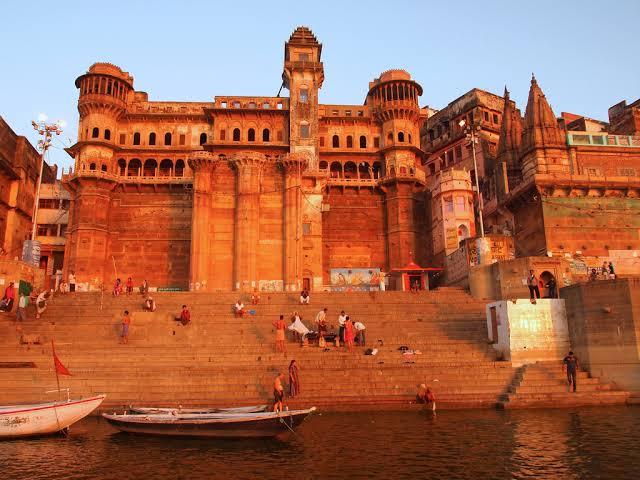
Nestled just a stone's throw away from the sacred Dasaswamedh Ghat, lies the serene and poignant Darbhanga Ghat. This hallowed site holds profound significance as it serves as a place for performing the solemn rites and rituals associated with the passing of a dear one. The ghat boasts an elegant and stately structure, offering a vantage point to witness these solemn ceremonies with utmost respect and reverence.
Highlights
1. Located between Chausatthi and Babua Pandey Ghat, it is one of the most serene and popular tourist destinations to visit in Varanasi.
2. It holds great religious and spiritual value for tourists. It serves as an open crematorium.
3. It is very famous for its sacred Shiva Temple at Nilkantha area and the shrine of Kukkuteswara.
4. It is named after the royal family of Darbhanga and they also built a magnificent palace with sandstone from Chunar.
Scindia Ghat
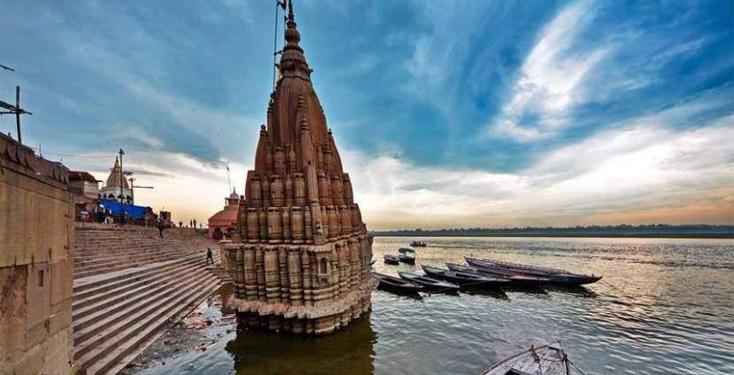
Scindia Ghat, also referred to as Shinde Ghat, holds a special place in Varanasi, renowned for its plethora of sacred sites. One of the main draws for tourists is the Shiva temple located at the ghat, which captivates with its mystical charm as it partly submerges in the water.
Steeped in Hindu mythology, this ghat is considered the very birthplace of Agni, the deity of Fire. It is no wonder then that Scindia Ghat is held in high esteem as a sacred destination, attracting countless devotees seeking blessings and spiritual solace. The tranquil ambience and sacred aura make it a cherished spot for many who yearn to experience its divine essence.
Highlights
1. Scindia Ghat is very popular for its partially submerged Lord Shiva Temple named- Ratneshwar Shiva Temple. It is said that the temple is unable to bear the weight of the Ghat. The temple has a very interesting story behind its submergence.
2. According to a tale, a boy named Man singh built a temple of Lord Shiva to pay all the debts he owed to his mother as his mother was in a relationship with a man but the boy disapproved of this relationship. He thought by building a temple he would be able to cut all the ties with his mother.
3. His mother was unable to end the relationship with that man so she told his son to cut all ties from her if he is able to do that by paying her debts. Upon visiting the temple his mother was angry and said that One Can never pay off the debts of a mother.
4. She cursed this temple and thus this temple remained submerged in water. During Summer the water of the holy river Ganga subside and the sanctum sanctorum of the temple remains visible which makes this temple one of the best tourist destinations to visit in Varanasi.
Ahilyabai Ghat
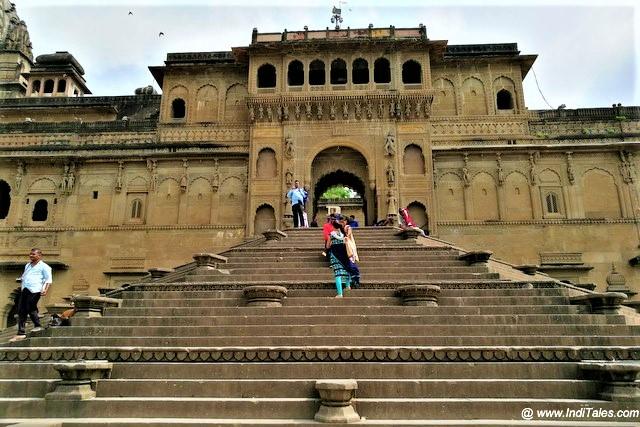
Ahilyabai Ghat, formerly known as Kevalgiri Ghat, underwent a magnificent transformation in 1778, thanks to the visionary Queen Ahilyabai Holkar. She orchestrated its renovation and skillfully crafted it using concrete, thus elevating it to prominence. What sets this ghat apart from others in Varanasi is its distinguished honor of being named after a remarkable individual.
For those seeking a serene experience, the morning hours prove to be the perfect time to venture to this enchanting ghat. The peaceful ambience draws Hindu devotees who come in great numbers to immerse themselves in the sacred waters, seeking spiritual purification and liberation from their sins.
Highlights
Most of the dead bodies are cremated in Ahilyabai Ghat. It is also known as Burning Ghat.
Morning is the best time to visit Ahilyabai Ghat for a holy dip into the sacred waters of the Ghat and wash away their sins for salvation.
Lalita Ghat
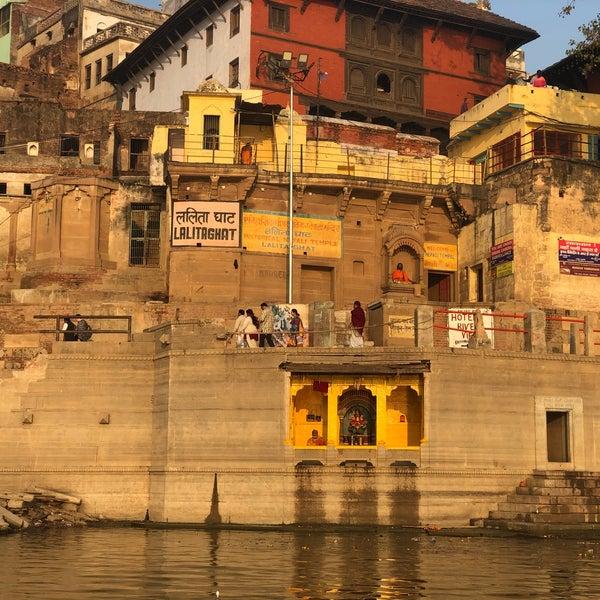
The enchanting world of Varanasi, where time seems to stand still, and spirituality weaves its magical tapestry. Among the many revered Ghats that adorn the sacred banks of the Ganges, Lalita Ghat stands tall as a symbol of divine beauty and devotion.
Gracing the Ghat is the exquisite wooden temple of Keshava, a masterpiece crafted in the traditional Nepalese architectural style. As you lay your eyes upon its majestic facade, you'll be captivated by the intricate carvings that adorn its walls, showcasing breathtaking sceneries that beckon art enthusiasts from far and wide.
Lalita Ghat owes its name to the revered Lalita Devi, the embodiment of the powerful Goddess Durga. It is believed that a dip in the holy waters of this Ghat will bestow upon devotees the blessings of the Goddess herself, ushering prosperity and abundance into their lives.
The air at Lalita Ghat is filled with an aura of devotion, and as the sun gently kisses the horizon, the atmosphere resonates with prayers and hymns offered to the divine. Witnessing this spiritual spectacle is an experience that leaves an indelible mark on the hearts of those who visit.
So, if you seek solace amidst the sacred waters and wish to immerse yourself in the embrace of the Goddess, then a visit to Lalita Ghat in Varanasi is an absolute must. Let its serene ambience and divine grace touch your soul, leaving you with memories to cherish for a lifetime.
Highlights
1. Lalita Ghat was built by the king of Nepal Rana Bahadur Shah in the 19th century.
2. Nepali Temple and Lalita Gauri Temple are the center of attraction of this Ghat.
3. The ghat got its name from Goddess Lalita who is the highest form of Goddess Adi Shakti.
4. Photography and boating are some of the best ways to relax and rejuvenate your soul in Lalita Ghat.
Rana Mahal Ghat
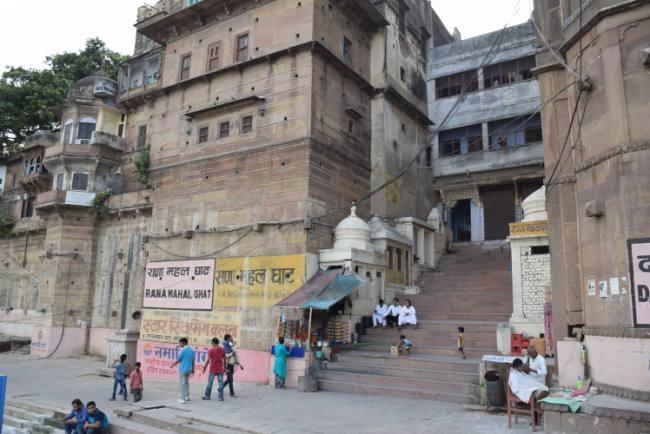
The exquisite Ghat constructed by the esteemed Raja Rana Jagat Singh, who embarked on a sacred pilgrimage to Varanasi. Adjacent to this serene spot, a magnificent palace stands as a testament to the Maharaja's stay during his spiritual journey. Embracing the opulent Rajputana architecture, this regal abode has become a charming attraction for numerous visitors and travelers alike.
Highlights
1. Rana Mahal Ghat is located in the south of Dasaswamedh Ghat.
2. The magnificent palace on the Ghat is an excellent example of Rajput art and architecture which will blow your heart away.
3. It is one of the Ghats under the ‘Revitalization of Varanasi’ Project launched by the regional tourism department for renovation and resurrection.
Chausatthi Ghat
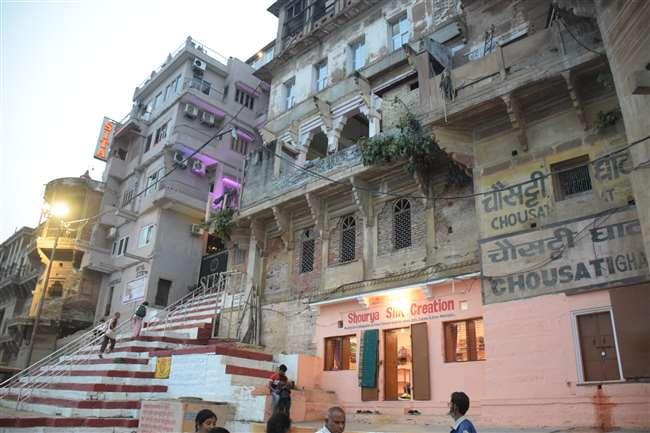
Chausatthi Ghat, nestled in the heart of Champaran, Bihar, is a place of extraordinary beauty and historical significance. This enchanting location is renowned for the magnificent palace erected by King Digbatiya, a testament to the region's rich heritage.
The ghat holds a special place in the hearts of many, as it once provided sanctuary to the esteemed Sanskrit scholar, Madhusudan Sarasvati. The serenity of the surroundings and the scholarly aura of Madhusudan Sarasvati's abode make it a site of admiration and reverence.
Venturing further into the ghat, one discovers a temple complex that echoes with the echoes of time. Ancient sculptures grace the temple, depicting revered deities like Kali, folk goddesses, Shiva, Ganesha, and Kartikeya. These mesmerizing images add to the allure and spiritual ambiance of the place.
The 12th dark-half of Chaitra, falling in the months of March and April, sees an influx of pilgrims flocking to the Yogini temple at Chausatthi Ghat. Seeking blessings and purification, they engage in ritual baths, forging a spiritual connection with the divine.
Another captivating time to visit is during the vibrant festival of Holi. As the eve of the festival approaches, devoted worshippers come together to pay their respects and partake in sacred rituals at the ghat. The atmosphere brims with joy and devotion, making it a truly unforgettable experience.
In essence, Chausatthi Ghat stands as a jewel in the crown of Champaran, drawing visitors with its historical charm, spiritual sanctity, and cultural festivities. A place where ancient and modern traditions intertwine, it continues to captivate the hearts of all who grace its sacred grounds.
Highlights
1. The ghat is dedicated to goddess Chausatthi, a form of goddess Kali.
2. It is an abode of a sanskrit scholar Madhusudan saraswati who wrote Vedanta Kalpa Latika which is a commentary on Bhagavad Gita.
Panchganga Ghat
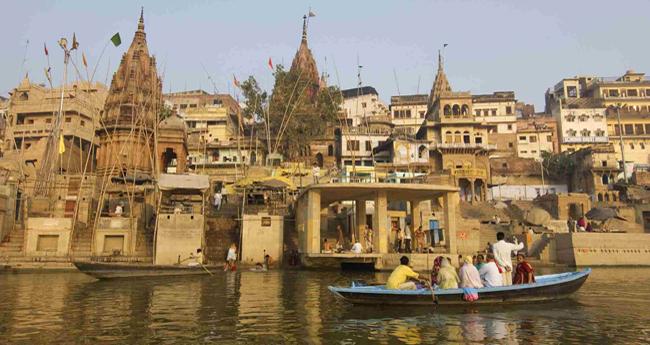
The enchanting Ghat, a place steeped in mythical tales and spiritual significance. This sacred site is renowned as the mythical meeting point of five sacred rivers, where their divine energies converge. Revered by countless devotees, it holds an aura of profound spirituality, drawing visitors from far and wide in pursuit of blessings from the five revered goddesses: Ganga, Yamuna, Saraswati, Dhutpapa, and Kirana.
As you wander along this revered Ghat, you'll encounter numerous captivating images of the five river goddesses, exquisitely carved and etched into the heart of this mystical place. Each idol, crafted from timeless black stone, stands as a testament to their eternal presence and power.
A visit to this sacred site is an experience like no other, as you witness the fervent devotion of devotees who come with hope in their hearts, seeking solace and blessings from these benevolent deities. The atmosphere is one of serenity and spirituality, offering a moment of respite from the hustle and bustle of daily life.
As you soak in the divine ambiance, your eyes will be drawn to the majestic Alamgir Mosque, a stunning architectural marvel that graces the horizon. Steeped in history, it is said to have been constructed by the legendary emperor Aurangzeb, adding yet another layer of intrigue to this sacred landscape.
In Varanasi, this hallowed Ghat is undoubtedly a must-visit for anyone seeking a glimpse into the spiritual essence of India. Its timeless allure, intertwined with folklore and devotion, makes it one of the most cherished and frequented tourist attractions in the region.
Come, embrace the enchanting mystique of this sacred meeting place and be captivated by the harmonious convergence of spirituality and history that resonates from every corner of this extraordinary Ghat.
Highlights
Some of the best places to visit near Panchganga Ghat are Nepali Temple, Mosque of Alamgir, Yoga Training Center and Scindia Ghat.